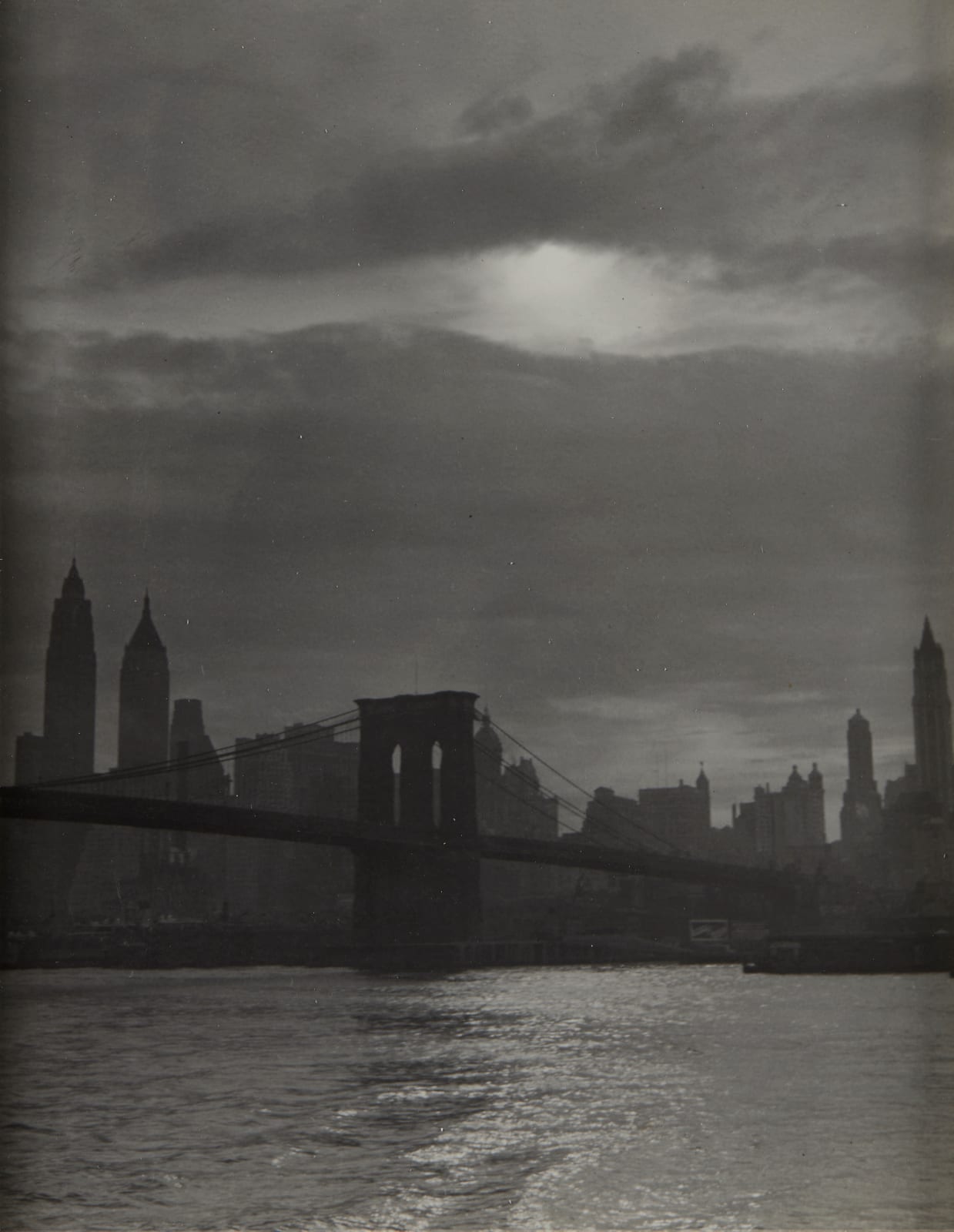
Dorothy Norman American, 1905-1997
Printed by the artist in 1932.
.
3 7/8 x 2 7/8 in
.
The photograph frames the Brooklyn Bridge from a low vantage point on the East River, emphasizing the rhythmic grid of its cables and towers. Norman’s decision to shoot from a boat creates a dynamic diagonal composition, with the bridge’s structural elements mirrored in the water’s rippled surface. The absence of human figures shifts focus to the bridge’s materiality—rust patterns on steel, weathered cables, and the interplay of light and shadow. This approach reflects her training under Alfred Stieglitz, who emphasized emotional resonance through formal precision.
Norman’s use of a Graflex camera, loaned by Stieglitz in 1931, allowed for sharp focus and rich tonal gradations. The small print size demands close viewing, inviting contemplation of textures often overlooked in grand architectural photography. Her darkroom expertise, honed at Stieglitz’s An American Place, is evident in the balanced contrast between the bridge’s industrial forms and the transient water reflections.
Created during the Great Depression, the image subtly engages with New York’s dual identity as a machine-age marvel and a site of economic struggle. The Brooklyn Bridge, completed in 1883, symbolized American progress but by 1932 had become a relic of an earlier era of optimism. Norman’s focus on corrosion and geometric repetition evokes themes of endurance and decay, mirroring the city’s socio-economic tensions.
Unlike contemporaneous photographers like Berenice Abbott, who documented the bridge in its urban context, Norman isolates its structural elements to highlight abstraction. This aligns with Stieglitz’s "Equivalents" series, where form transcends literal representation to evoke emotional states. The photograph’s title—referencing New Bedford, Massachusetts—hints at maritime connectivity, positioning the bridge as a nexus of regional commerce and movement.
First exhibited in 1968 as part of Norman’s donation to the Philadelphia Museum of Art, the work gained broader recognition in the 1993 International Center of Photography (ICP) exhibition Intimate Visions: The Photographs of Dorothy Norman. Critics noted its "haiku-like" compression of urban energy into meditative stillness, a hallmark of her non-commercial practice. The photograph’s inclusion in portfolios such as Dorothy Norman: Selected Photographs(1995) underscores its status as a key example of her ability to distill complex subjects into minimalist elegance.
Art historians have interpreted the image as a visual metaphor for New York’s interconnected systems—the bridge’s cables mirroring the invisible networks of transit and trade that sustained the city during the 1930s. The juxtaposition of monumental steel against fluid water reflections underscores the tension between permanence and transience, a recurring theme in Norman’s work.
While Margaret Bourke-White’s contemporaneous bridge photography emphasized human activity and scale, Norman’s approach is introspective. Her focus on texture and pattern aligns with her writings in Twice a Year, where she argued for art’s role in fostering social consciousness through contemplative engagement.
Brooklyn Bridge from the Boat to New Bedford exemplifies Dorothy Norman’s unique contribution to 20th-century photography. By merging Stieglitz’s formal rigor with her own poetic sensibility, she transformed an industrial landmark into a meditation on modernity’s contradictions. Preserved in collections such as the Whitney Museum and the Mead Art Museum, this work remains a vital lens through which to view New York’s evolving identity.
Join our mailing list
* denotes required fields
We will process the personal data you have supplied in accordance with our privacy policy (available on request). You can unsubscribe or change your preferences at any time by clicking the link in our emails.